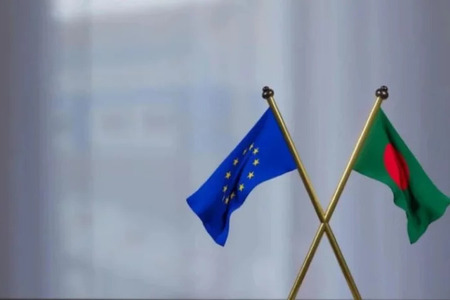Pakistan despite quality yarn to perform poorly in cotton export
YarnsandFibers News Bureau 2016-03-07 17:00:00 – KarachiPakistan despite being the fourth largest producer of cotton has been performing poorly in cotton trade. The cotton consumption is likely to decline by 12 percent this year. By consuming 2.2 million tons of cotton, Pakistan would be exporting around $13 billion of cotton products whereas with the same quantity of combined cotton production Bangladesh and Vietnam would generate exports of $54 billion, according to a recent cotton update by the International Cotton Advisory Committee.
Pakistan’s consumption of cotton will be equal to the combined consumption of the silver fibre in Bangladesh and Vietnam where it is likely to register an increase of 22 percent and 13 per cent respectively.
Accounting for 80 percent of exports and employing 40 percent of industrial workforce, Bangladesh’s garment sector specializes in low-end clothing and is the main industry of the impoverished nation, which has emerged as the world’s second largest producer of apparel.
This means that value addition in these two non-cotton producing countries is over four times higher than Pakistan. However, both Bangladesh and Vietnam are among the low value-added textile exporting countries, while China, Turkey, Sri Lanka and Tunisia add much more value to their textiles.
Considered worldwide an important cash crop once, the South Asia Subcontinent was the world leader in cotton textile exports. However, the Subcontinent’s position faded in the 18th century, when the British empire created a monopoly for its own manufacturers at home, choking the textile centres in the areas now constituting Pakistan and India.
Meanwhile, cotton has played a significant role in the industrial growth of many countries. According to Australian economist J.A. Schumpeter, England owes its ascendance to a single industry — the textiles. The same can be said of China and the rest of East Asia.
Japan used cheap labour to surpass England to become the leading exporter of cotton garments by 1930. When Washington forced Tokyo to accept ‘voluntary’ quota in 1955, Japanese investors’ instinct to stay in business impelled them to fund garment companies in Hong Kong, Taiwan and South Korea. Japanese intervention in East Asia led to the upgradation and modernisation of garment industry in the region. In due course, labour-intensive garment factories laid the seeds for broad-based industrialisation in East Asia, working spectacularly in China after its opening up in 1980s.
With an annual harvest of around 13 million bales, Pakistan is the fourth largest producer of cotton, producing about 10 per cent of the total global production of cotton. Pakistan’s textiles industry consists of 11.3 million spindles, 03 million rotors, 350,000 power looms and some 18,000 knitting machines. It has 700,000 industrial and domestic stitching machines. In addition, it has a strong fibre base of 13 million bales of cotton and 600,000 tons of manmade, including polyester fibre. There are 21 filament yarn units having capacity of 100,000 tons. The filament and yarn industry is supported by PTA plant which has 500,000 tons capacity. Unlike many competitors which have only primary base or the finished base, Pakistan’s textile industry has a complete value chain which is rare in the world.
In yarn production, until 2006, Pakistan was one of the most efficient producers of yarn around the world because it possessed better technology than India, China or Bangladesh. But, Pakistan’s textile industry halted its upgrade, and its technology is now older than all the three regional countries.
As the new spinning equipment is more energy efficient and its production speed is also higher, it has enabled other economies to either match or lower the spinning costs compared with Pakistan. Consequently, the last 18 months have been a nightmare for the energy intensive spinning and weaving industry of Pakistan due to high power tariff and energy shortages. Despite the recent power tariff reduction of Rs3 per unit, the spinning industry is reportedly still facing problems. However, Pakistan’s quality yarn is bringing back global buyers, who are reportedly disappointed by inconsistent and low quality Indian yarn. Though yarn exports from Pakistan are slowly picking-up, around 110 spinning units are still closed down.
Cotton and its value added products chain contribute about 57 per cent to Pakistan’s annual export income. A couple of indigenous industries, such as pharmaceutical, soap, chemical and feed, rely heavily on cotton by-products. Besides, cotton provides livelihood to 1.5 million farming families and jobs to about 40 per cent of the country’s labour force. In view of its contribution, cotton is often called the life-blood of Pakistan’s economy.
Furthermore, God has endowed Pakistan with cotton which is very good in quality due to its fibre strength and uniformity. But, Pakistani cotton gets lower price in the international market because of problems that affect its quality, thereby causing huge losses in export of cotton and its value addition chain — yarn, cloth, made-ups, linen, knitwear, garments, etc.
Keeping in view the importance and contribution of cotton to its national economy, the government in 2004 created a Ministry of Textiles to deal with this sector exclusively. Since then there has been a lot of rhetoric about shifting the ‘textile sector from commodity to specialty, value addition, skills and vocational training programmes, establishing textile cities, model garment factories, modern textile laboratories, textile research institutes and special economic zones to facilitate export specific textile industries. However, the export of Pakistan’s textiles, despite subsidies and concessions to the textile industry has continued to decline in the country’s overall exports.
Pakistan’s textile tycoons are themselves partly responsible for the sorry state of affairs in this sector because despite availing subsidies in billions, they have neither been able to improve the quality of their products nor bring this sector in conformity with the modern day requirements. Instead of taking a cue from Sialkot’s enlightened entrepreneurs (engaged in the sports, cutlery and surgical instruments industry who instead of demanding that the government upgrade and improve their region’s infrastructure, have created many infrastructural facilities, including an international airport, on self-help basis), the influential textile lobby remains engaged in efforts to get subsidies. In view of the lacklustre performance of this sector, it would be prudent to link subsidies to the quality of the product and the actual performance of textile sub-sectors.
Pakistan’s textile sector has remained stagnant over the last decade largely due to high cost of doing business, global recession and subsidies given by the competing countries to their industry. Taking stock of the situation, the government announced the Second Textile Policy 2014-19 on February 15, 2015. This policy aims at making textile sector more competitive, robust, goal-oriented and sustainable. The policy envisages to double textile exports from $13 billion to $26 billion per annum in the next five years. Converting more primary raw materials into value-added product, increased productivity and quality will be the prime focus of this policy.
Despite the second Textile Policy, the country’s textile exports have reduced by 14 per cent over the last six months. If this trend is allowed to prevail, it could lead to a reduction of $3.5 billion in exports by the year’s end, according to Aamir Fayyaz, Chairman APTMA Punjab Zone. Earlier cotton crop failure in Punjab had resulted in $1.5 billion loss to farmers.
Keeping the buying and selling potential of the country’s textile and garments industry in view, Pakistan Readymade Garments Manufacturers and Exporters Association has announced to hold 15th Textile Asia 2016 International Textile and Garment Machinery Trade Fair from March 9-11, 2016 in Karachi. According to the organizers, the trade fair will have more than 550 international brands displaying their products in over 700 booths, and over 500 foreign delegates mainly from Austria, China, Czech Republic, France, Germany, India, Italy, Korea, Taiwan, Turkey, UK and US are likely to attend the event.
Market Intelligence
Ask for free sample Report

experience
Customer Base
dedicated team
Countries Served Worldwide




![Freitag unveils new Mono[P6] circular backpack](https://www.yarnsandfibers.com/wp-content/uploads/2024/04/Freitag.jpg)




